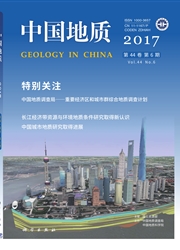

 中文摘要:
中文摘要:
深井水温观测在中国已经开展了20多年,但目前对于水温响应机理的研究还不充分。而且利用温泉水对水温响应机理研究甚少。本文在2008年5月12日汶川8.0级地震前后,即2008年5月1日至7月4日,对重庆北温泉水(距震中约400km)进行采样监测,发现泉水水温水量发生较大变化震后水温下降了1℃;海拔相对较高的BWQ-2、BWQ-3、BWQ-4相继断流,监测点BWQ-1的水量增加了15L/s;与此同时,各泉点Fe^3+、Mn^2+浓度于地震当日成倍增长,随后逐渐减小,7月4日时浓度与5月1日相当。重庆北温泉位于四川盆地东部边缘地带,受汶川地震强烈影响导致冷水下渗作用,海拔相对较高而温度较低的温泉水改道,并有其他来自裂隙或者地表的低温水汇入温泉含水层,Fe^3+、Mn^2+浓度的变化从水化学上印证了冷水下渗学说。
 英文摘要:
英文摘要:
Water temperature observations in deep wells have been carried out in China for more than 20 years,but the researches on the mechanism of temperature response remain inadequate,and very few researchers have studied this mechanism for hot spring water.In this paper,the Beiwenquan hot spring of Chongqing was continuously monitored from May 1 to July 4,2008.During the May 12 Ms 8.0 earthquake of 2008,the Beiwenquan hot spring about 400 km from the epicenter had a huge response to the earthquake.After the earthquake,three relatively high elevation springs were cut off,and the discharge of some other springs increased by nearly 50%.The concentration of Fe3+ and Mn2+ increased twofold on May 12 and then decreased gradually.On July 4,the concentration of Fe3+ and Mn2+ was the same as that on May 1.This is attributed to the active development of karst areas in the Jialingjiang River valley which has numerous fissures and cracks.Because of the earthquake,the higher elevation springs whose temperature was lower than that of other springs and surface water came from the fissures and infiltrated into the lower elevation springs.This process accelerated the vertical movement of the water and the mixing of different waters.
 同期刊论文项目
同期刊论文项目
 同项目期刊论文
同项目期刊论文
 Modeling hydrological responses of karst spring to storm events: example of the Shuifang spring(Jinf
Modeling hydrological responses of karst spring to storm events: example of the Shuifang spring(Jinf 期刊信息
期刊信息
